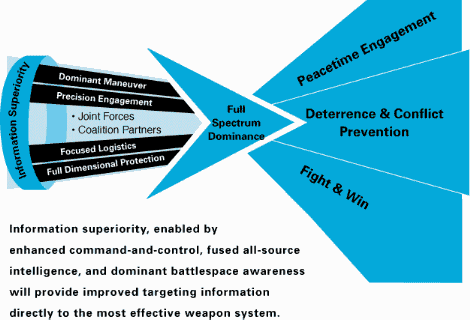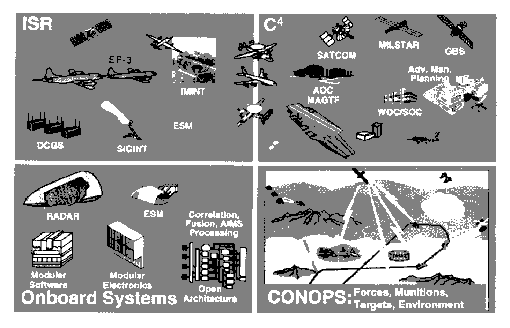C4ISR
Naval Aviation has entered the Information Age, where the speed and
thoroughness in which accurate information is collected, analyzed, disseminated,
and protected are of paramount importance. Joint Vision 2010
states that information superiority is achieved by effective command, control,
communications, and computer (C4) links and the fusion of intelligence,
surveillance, and reconnaissance (ISR) information, which in turn can lead
to dominant battlespace awareness.

With its current and planned systems, Naval Aviation provides a command
and-control and sensor architecture to shape joint operations, as well
as the airborne platforms to support them. The capability to provide direct
links to the Joint Force Commander at sea from airborne reconnaissance
platforms provides real-time ELINT, SIGINT, and high resolution SAR/MTI
and optical tracking from long-range, long endurance P-3s, detailed tactical
reconnaissance of the battlefield from F-14s and F-18s, and an explicit
electronic order of battle from ES-3s, EP-3s, and EA-6Bs. Aircraft sensors
and communications systems extend the field of view for the Joint Force
Commander hundreds of miles beyond the horizon while providing direct connectivity
to both the Joint Force Air Component Commander and the MAGTF ashore. Two
examples of key elements embedded in our current C4/ISR system include
the Cooperative Engagement Capability (CEC) and Link 16/Joint Tactical
Information Distribution System (JTIDS). CEC significantly improves battle
force anti-air warfare capability by integrating the sensor data of multiple
ships and aircraft into a single, real-time, fire-control quality composite
track picture. Operating under the direction of a designated commander,
CEC will enable a battle group or Joint Task Force to act as a single defensive
combat system. Link 16/JTIDS is a high-capacity, digital information distribution
system that provides rapid, secure, and jam resistant communications, navigation
and identification capabilities for naval tactical aircraft.

Advanced technologies also allow Naval Aviation to monitor and protect
the world's critical sea lines of communication. The Navy maintains a worldwide
Maritime Command/Surveillance Tactical Support Center (TSC) network. TSCs
serve as nodes in the Joint Maritime Command Information System (JMCIS),
an integrated C4I system that provides commanders afloat and on shore with
a comprehensive picture of friendly, hostile, and neutral forces on land,
at sea, or in the air. The TSCs are supplemented by Mobile Operations Command
Centers; ground communication and control stations that can be quickly
transported by P-3C Orion aircraft to remote locations.
In the area of preflight mission planning, Naval Aviation is relying
increasingly upon systems such as the Tactical Automated Mission Planning
System (TAMPS). TAMPS allows tactical data to be loaded quickly and efficiently
into aircraft computers and software, improving the overall ability of
our aircrews to employ their aircraft and weapons. It also includes broader,
force level decision-support features, and it is compatible with JMCIS
and other joint systems.
Naval Aviation's leveraging of information will continue to expand
in the future. Ultimately, its C4/ISR architecture must have the ability
to support airborne strike packages and other airborne assets with real-time
intelligence, fused together from a wide array of sources and systems.
It also will have the ability to send this imagery, video, and other information
to strike and support aircraft via data link.
 System
Overview
System
Overview  Safety
Safety  Affordable
Avionics
Affordable
Avionics  C4/ISR
C4/ISR  Aircraft
Carriers
Aircraft
Carriers  Carrier
Air Wings
Carrier
Air Wings
 F-14
Tomcat
F-14
Tomcat  F/A-18
Hornet
F/A-18
Hornet  Joint
Strike Fighter
Joint
Strike Fighter  Airborne
Reconnaissance Vision
Airborne
Reconnaissance Vision  E-2C
Hawkeye
E-2C
Hawkeye  S-3B
Viking
S-3B
Viking
 ES-3A
Shadow
ES-3A
Shadow  Common
Support Aircraft
Common
Support Aircraft  EA-6B
Prowler
EA-6B
Prowler  Helicopter
Master Plan
Helicopter
Master Plan
 Marine
Corps Fixed-Wing Aircraft
Marine
Corps Fixed-Wing Aircraft  Marine
Corps Rotary-Wing Aircraft
Marine
Corps Rotary-Wing Aircraft  P-3C
Orion
P-3C
Orion  EP-3E
Aries II
EP-3E
Aries II  E-6A/B
Mercury
E-6A/B
Mercury
 Air-to-Air
Missiles
Air-to-Air
Missiles  Air-to-Ground
Weapons
Air-to-Ground
Weapons  Air-to-Subsurface
Weapons
Air-to-Subsurface
Weapons  Naval
Reserve Aviation
Naval
Reserve Aviation  Logistics
Airlift
Logistics
Airlift
 Training
Aircraft
Training
Aircraft  Aircrew
Training
Aircrew
Training  Aviation
Specialized Skills Training
Aviation
Specialized Skills Training  Logistics
Logistics  Expeditionary
Airfields
Expeditionary
Airfields
 Air
Traffic Control
Air
Traffic Control  Ranges
and Airfields
Ranges
and Airfields



